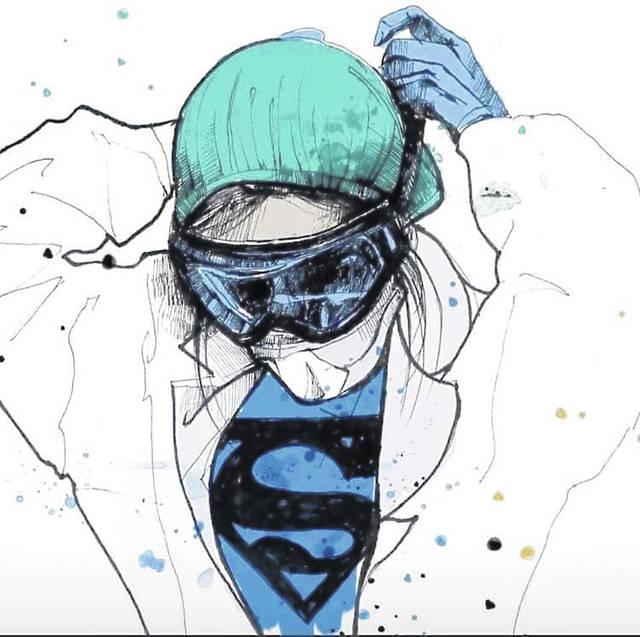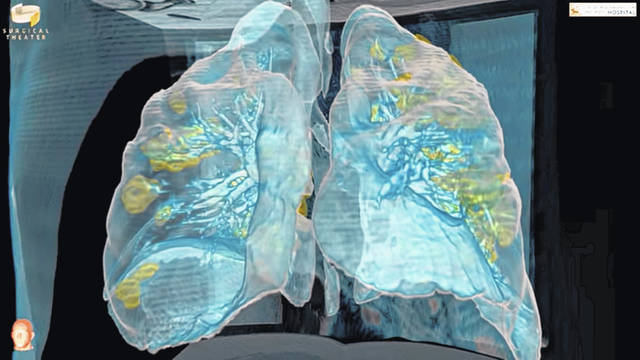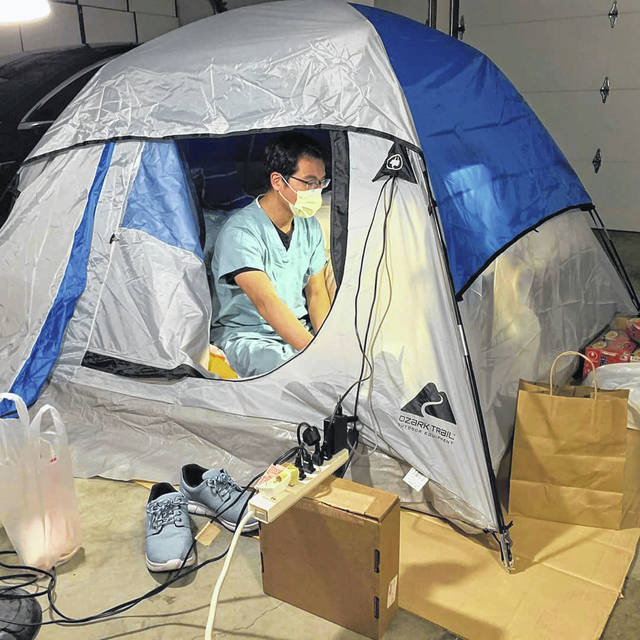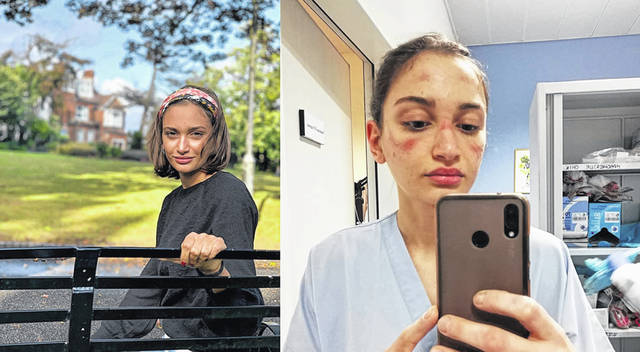



“Tonight, I realized a patient was likely going to die within the next few minutes from complications of COVID-19. As I glanced at the 12 IV pumps running, including three maxed out pressors to support his blood pressure, I realized there was absolutely nothing I could do. I called for my charge nurse who FaceTimed his wife, handed me her personal cellphone into the airlock room … She asked me if he would be allowed a proper funeral. She asked if she could be there. And sadly, I had to say no.”
These are the words of a nurse who wished to remain anonymous out of a fear of losing her job. It was a day she learned what it is like to sit beside a man while his family waited in a car outside the hospital as he died, not allowed to hold his hand and say goodbye.
Those who work in the nursing profession like the young woman above have been handed what may be the most serious public health crisis of their generation. They are not expected to complain or ask for hazard pay, even when asked to recycle their personal protective equipment (PPE) or are told to work without it.
“I’ve never seen anything like it,” said Christine Tsouris, an Emergency Department RN in the Henry Ford Health System on a public Facebook post. “I ask myself, ‘How are we going to survive this?’”
Before her shift on Tuesday night, Tsouris didn’t know what she was in for, but she knew it was bad. “My boss was crying and took us all down to the chapel to pray,” she said.
Over her shift, she observed the disease progress in one patient after another.
“The virus takes over your whole body. Your lungs become tight, swelling everywhere, sweating, gasping for air, your heart is swollen and working in overdrive,” said described. “My patient last night deteriorated over 5 hours. He was a 1 to 1 patient. If I wasn’t standing right there with him, he would’ve died. His family was sitting in the car for 5 hours waiting to hear how he was doing … These people come into the hospital not knowing if they will come back out alive. [I know some will] die alone … We had only 4 ventilators left in the whole hospital last night. It is almost time to start cutting out the sickest and forcing the docs to make the hardest decision—to just let them die.”
“Nurses are breaking down now. We leave work crying, including myself last night, and we all know this is only the beginning,” Tsouris said. “I’m scared I will carry this home. [My husband and I] don’t kiss anymore. I can’t hug my family when I need a hug most. I am scared.”
Tsouris is not the only one.
Nicole Moanikeala LeMaster Mendoza, known to her friends as “Coco,” is a healthcare worker, but she is also the mother to a young girl and doing everything she can to protect her.
“I wake up in fear … The anxiety builds as I turn and look at my daughter and instantly cry… I’m a mother. I’m also a healthcare worker. The combination gives me a new-found obsessive-compulsive disorder to protect myself in order to not let the two lifestyles from mixing. Bleach is my new shower. Sanitary mode on the washer is my new normal … Scrubbing my house from the doorbell to the back porch is still not enough to calm my anxiety. I don’t know if I or the world will ever be the same,” Mendoza posted publicly on Facebook.
Timmy Cheng, a medical doctor in Orange, California, chronicled the end of his workday publicly on social media:
“March 14, 2020 was a big day. This was the day our first COVID-19 patient got intubated and came under my care in the ICU. 3/14/2020 is also the day I voluntarily became homeless to protect my family should I become infected and bring the virus home. I spent 1 night in my car, then 4 nights in the hospital call room. On day 5 my wife came up with the idea for me to live in a tent in our garage. So, here it is. My home for the next weeks or months,” Cheng wrote.
According to the Johns Hopkins Coronavirus Resource Center (https://coronavirus.jhu.edu/map.html), with 69,197 confirmed cases as of Thursday at 9:32 a.m., this week or early next week the U.S. appears poised to surpass the number of confirmed COVID-19 cases in Italy that has 74,386.
As more tests are issued, figures closer to reality begin to emerge, and as such, Margaret Harris from the WHO predicted Monday that “the U.S. could become the new COVID-19 epicenter,” as a spike in numbers showed the U.S. had more than 40 percent of all new cases in the world.
“This week it is going to get bad,” U.S. Surgeon General Jerome Adams confirmed Monday on the Today show.
Should the disease progress similarly as in Italy, nurses in the U.S. may be facing similar hardships as their Italian counterparts.
Italian healthcare workers have been the hardest hit by COVID-19, with over 7,503 deaths as of Thursday, March 26, more than double the 3,285 deaths in China.
“I am a nurse and right now I am facing this medical emergency… . I’m afraid to go to work. I am afraid because the mask may not adhere well to the face, or I may have accidentally touched myself with dirty gloves, or maybe the lenses do not completely cover my eyes and something may have passed. I am physically tired because the protective devices are bad, the lab coat makes me sweat and once dressed I can no longer go to the bathroom or drink for six hours. I am psychologically tired, and as are all my colleagues who have been in the same condition for weeks,” writes Italian nurse Alessia Bonari on her public Instagram post that has more than 1 million likes.
In addition to fear, psychological stress and guilt can take a serious toll on health workers. On Wednesday, The Daily Mail reported that Italian nurse Daniela Trezzi was one of roughly 4,824 Italian healthcare workers who had fallen ill while treating COVID-19 positive patients. After testing positive for COVID-19 herself, distraught and worried that she could have infected her patients, she committed suicide at age 34. Trezzi had been working in the intensive care unit at San Gerardo Hospital in Lombardy.
As hospital supplies dwindle in areas like New York City, staff are asked to adopt some of the desperate measures used overseas, like substituting trash bags for protective gowns. Kious Kelly, age 48, an assistant nursing manager at Mount Sinai West, died Tuesday after being told to wear a garbage bag for protection, dying in the same hospital where he had worked, treated by colleagues, the New York Post reported Wednesday.
A testing kit shortage is one reason Rachel Occhipinti, wife and mother of two children, has not been tested, even though she is out sick. Ironically, she is a Clinical Laboratory Assistant in the main lab at the busiest California hospital in her area.
“It quite upsetting. Because I’ve had no fever, but all the other symptoms like fatigue and shortness of breath with coughing, I’m not eligible to be tested. Honestly, we should be the first ones tested. Who else is going to do our job?” Occhipinti wonders, and so do we.
How can we prevent such tragedies?
More than 1.2 million signatures a Change.org petition against new CDC rules that reduced standards requiring N95 respirators to facemasks due to “supply chain” issues. But the FDA advises that these cannot protect against small droplets. Now short of even facemasks, the situation has deteriorated. On a webpage called “Strategies for optimizing the supply of facemasks,” the CDC advised, “in settings where facemasks are not available, HCP might use homemade masks (e.g., bandana, scarf) for care of patients with COVID-19 as a last resort. However, homemade masks are not considered PPE.”
Wednesday, the U.S. Senate passed a $2 trillion COVID-19 stimulus funding package that allocates $16 billion for PPE, which could put the U.S. on a better footing to receive much needed supplies when competing in a bidding process in a marketplace facing a global shortage.





